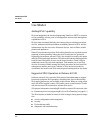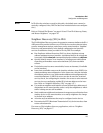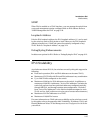
2-14
Introduction to IPv6
Diagnostic and Troubleshooting
Domain Name System (DNS) Resolution
This feature enables resolving a host name to an IPv6 address and the reverse,
and takes on added importance over its IPv4 counterpart due to the extended
length of IPv6 addresses. With DNS-compatible commands, CLI command
entry becomes easier for reaching a device whose IPv6 address is configured
with a host name counterpart on a DNS server.
Software release K.13.01 includes the following DNS-compatible commands:
■ ping6
■ traceroute6
The switches covered by this guide now support a prioritized list of up to three
DNS server addresses. (Earlier software releases supported only one DNS
server address.) Also, the server address list can include both IPv4 and IPv6
DNS server addresses. (An IPv6 DNS server can respond to IPv4 queries, and
the reverse.)
Note If an IPv6 DNS server address is configured on the switch, at least one VLAN
on the switch (and in the path to the DNS server) must be configured with an
IPv6 address.
For information on configuring DNS resolution on the switch, refer to “DNS
Resolver for IPv6” on page 8-9.
IPv6 Neighbor Discovery (ND) Controls
The neighbor discovery feature includes commands for:
■ increasing or decreasing the frequency of Duplicate Address Detection
searches
■ displaying the IPv6 neighbor cache
■ clearing dynamic entries from the neighbor cache
Refer to “Neighbor Discovery (ND) in IPv6” on page 2-9.
Event Log
Messages returning IP addresses now include IPv6 addresses where appli-
cable.


















